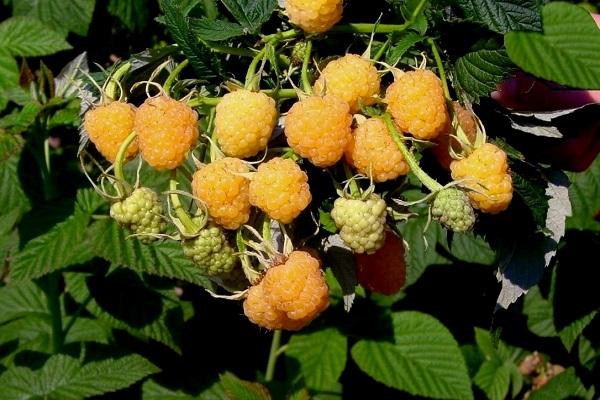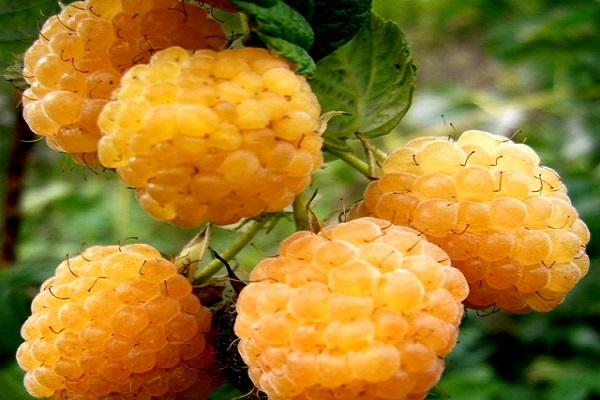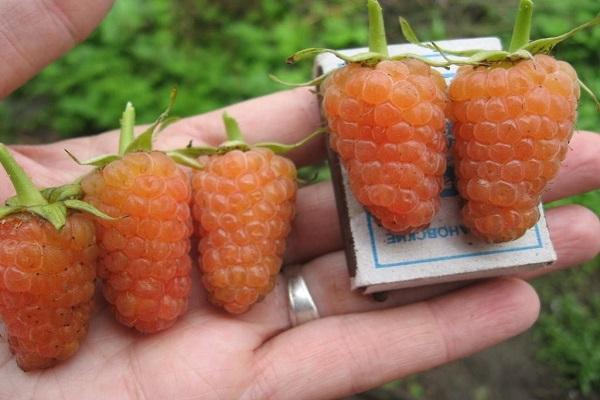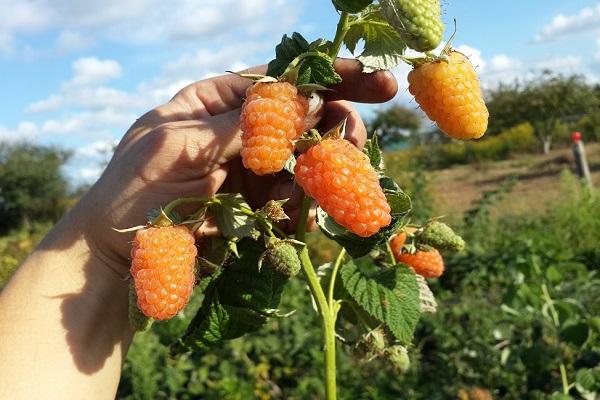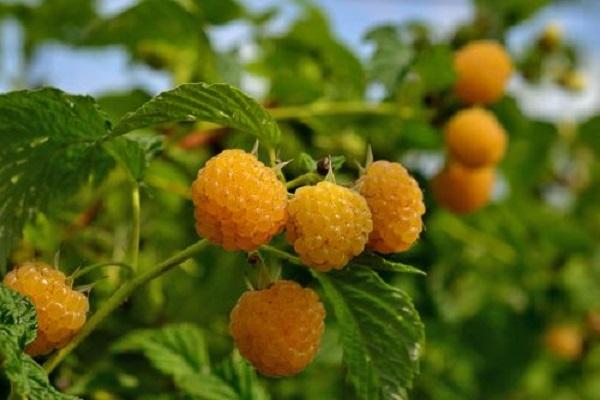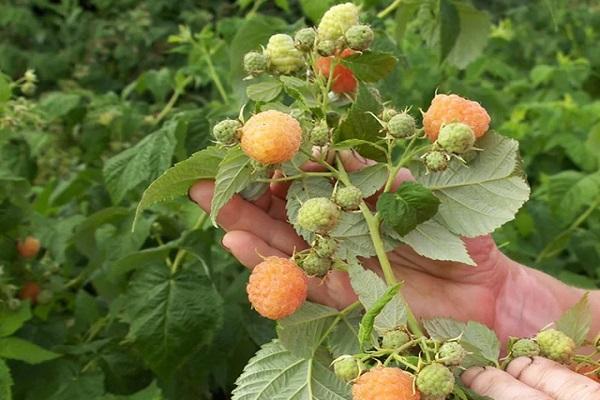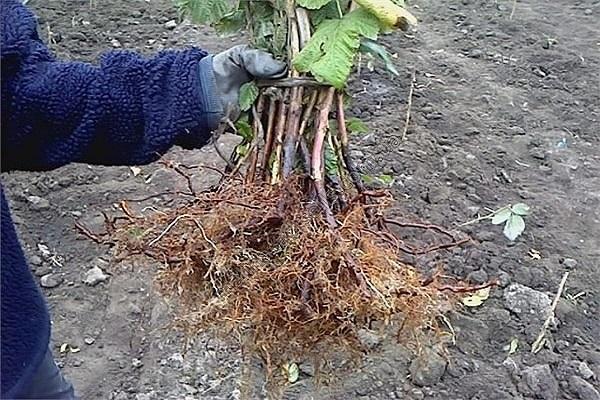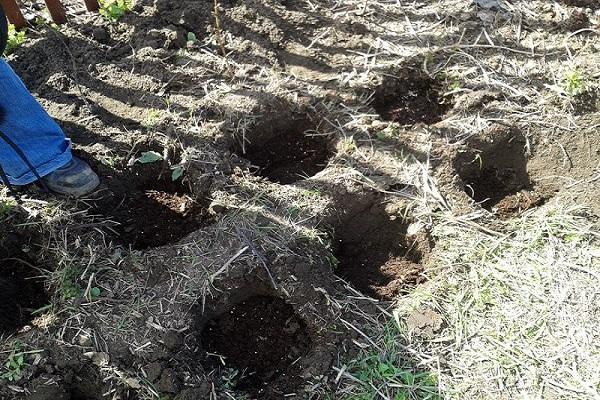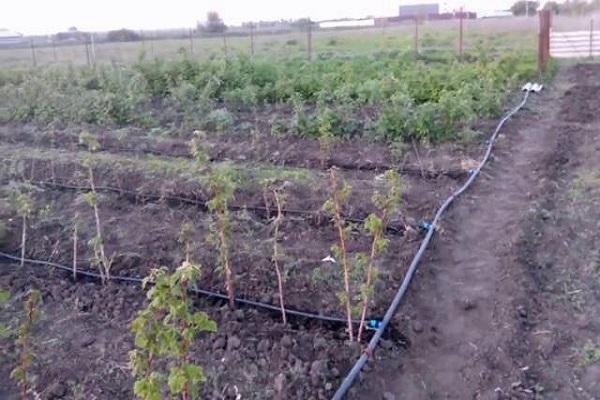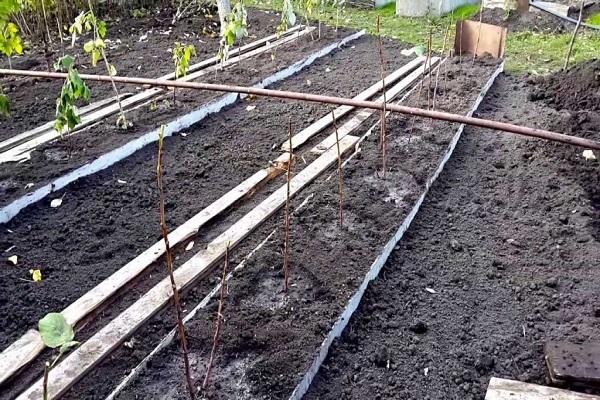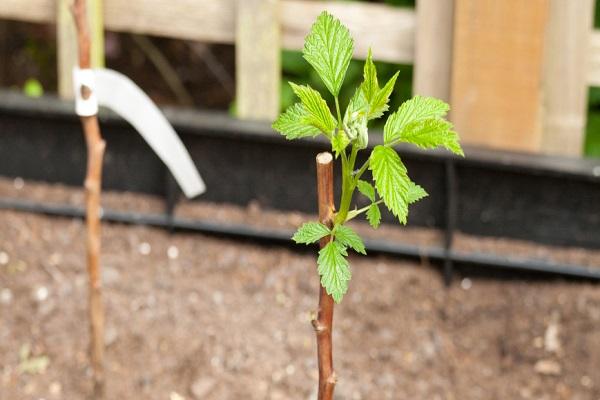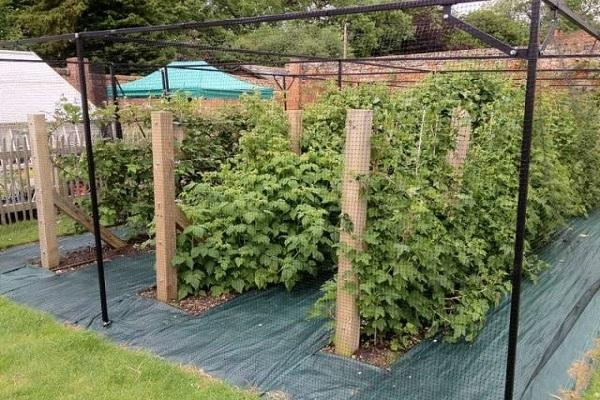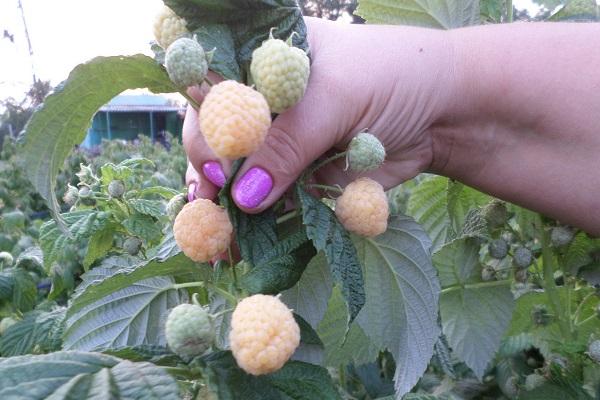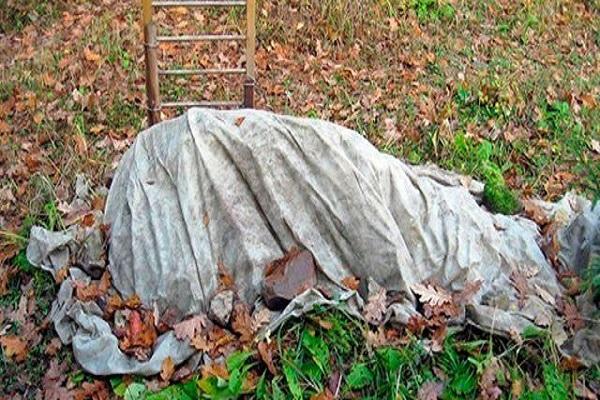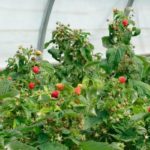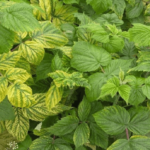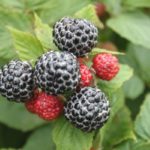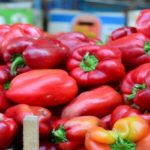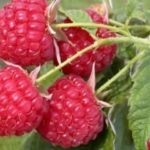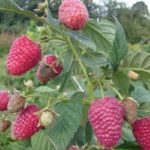There are many varieties of raspberries. The usual red berry can be replaced by yellow, black, and white varieties. Growing and caring for yellow raspberries is not much different from cultivating the red variety, but there are some nuances in the agricultural technology of this unusual garden crop. The popularity of yellow-fruited raspberries is that they bear fruit all summer, and their berries are hypoallergenic.
- Features of yellow-fruited raspberries
- How is it different from the usual
- Soil and climate suitable for cultivation
- The best varieties of yellow raspberries
- Morning dew
- Orange miracle
- Yellow sweet tooth
- Apricot
- Golden assortment
- Golden autumn
- Planting a crop on the site
- The best time to carry out work
- Choosing a landing site
- Schemes and step-by-step guide for planting bushes
- Nuances of care
- Watering
- Fertilizing bushes
- Tying up
- Weed control
- How to prune a crop
- Protection from pests and diseases
- Sheltering yellow raspberries for the winter
- How to propagate yellow raspberry bushes
Features of yellow-fruited raspberries
The yellow variety of raspberries is a perennial subshrub, reaching a height of 1.5-2 meters. With good care, the plant can stretch up to 3 meters. In terms of its characteristics, the culture is close to its relatives. Therefore, when asked whether it is possible to plant yellow and red raspberries next to each other, they answer in the affirmative. This way you can improve the decorative quality of berry plantations.
Representative of the Rosaceae family:
- undemanding to heat, not tolerating heat well;
- grows better in the shade of trees;
- sensitive to lack of moisture due to the shallow root system;
- It develops better on soils amended with organic fertilizers.
The raspberry root system is classified as a perennial type. It lies 30-40 centimeters from the surface of the earth. The roots do not go deeper than 85 centimeters into the ground. Horizontally, the roots extend 3 meters to the side. They begin to lay buds, from which young shoots appear. By autumn, root shoots are formed. Shoots also develop from the base of the uterine stems. They replace fruit-bearing branches, which die off by autumn.
How is it different from the usual
There are no particular differences between red and yellow raspberries. The yellow-fruited variety is used for site design. Large orange and yellow berries are juicy and sweet. But they do not retain their shape for a long time and wrinkle. Therefore, they are immediately used for food and for making desserts. The jam made from yellowish fruits is tasty, but the appearance of the preparations is unremarkable. Therefore, you can use red and yellow berries together.
Those who like fresh berries choose a crop for planting, especially since its yield is high compared to other types of raspberries.
Berry varieties tolerate frost well and bear fruit throughout the summer season.
Soil and climate suitable for cultivation
A good harvest of yellow berries is obtained when:
- summer temperatures reach 20-25 degrees, and winter temperatures range from 22-24 degrees;
- cover plantings in areas with harsh winters;
- fertilize plantations on time;
- keep snow in the garden to cover the bushes.
Raspberry bushes take root and bear fruit successfully in central Russia, the Moscow region, and the Altai Territory. The crop is grown in Siberia and the Urals, choosing a mid-early plant species.
The best varieties of yellow raspberries
Varieties developed by breeders, such as the Yellow Giant remontant raspberry, are considered the best among berry plants. The crop bears fruit both in summer and autumn. Amber fruits are valuable for their pleasant aroma and sweet taste. They are so juicy that they melt in your mouth. Although large berries cannot be stored for a long time, their high yields allow you to feed a large family with healthy raspberries.
Morning dew
Polish biologists have developed a raspberry variety whose fruits are:
- dense;
- sweet and sour;
- orange;
- weighing up to 10 grams.
On bushes 1.8 meters high, berries appear in June, the second ripening occurs at the end of summer. If they want to get more harvest, then they grow it as an annual crop, harvesting the fruits once.
The disadvantages of the hybrid include the fact that the sweetness of the raspberries depends on the air temperature. In addition, Morning Dew has poor resistance to disease and fungal infections.
Orange miracle
One of the sun-loving varieties that does not tolerate shade well.The advantages of raspberries include their frost resistance, ease of care, and resistance to pathogenic fungi. The bushes are low, 1.5 meters, so they don’t need a garter.
The hybrid's berries are cone-shaped, and ripe fruits acquire a beautiful orange tone. Due to their high density, they are well preserved and do not wrinkle during transportation. The yield with good care is 2-4 kilograms per plant.
Yellow sweet tooth
Raspberries of this variety are famous for their whitish berries with a slight yellowness. They have a pleasant pineapple taste. Medium-sized fruits do not crumble, but during transportation they become very wrinkled and lose their presentation. From spreading bushes with smooth shoots 1.5 meters high, a harvest of up to 6-8 kilograms is harvested.
The culture is distinguished by high immunity to diseases, but does not tolerate cold well.
Apricot
Apricot raspberries are the most fruitful. Fruiting begins in the 1st year after planting. The shoots of the plant are strong and straight. Young ones are light brown in color. Over the years they darken. The round, apricot-colored berry is soft in consistency, with a small amount of hair. According to taste, raspberries are rated 4.5 points. The yield of the hybrid reaches 3 kilograms per bush. The advantage is resistance to major diseases.
Golden assortment
Large-fruited type of raspberry with white, yellowish berries. It resembles the description of the Yellow Giant raspberry variety, which has:
- powerful spreading bushes;
- high rate of shoot formation;
- berries weighing 12-15 grams;
- sugary fruit pulp;
- Maturation takes a long time, over 1.5 months.
The recognized leader among yellow-fruited raspberries is valued among gardeners. Everyone dreams of raising him.
Golden autumn
The variety is recommended for cultivation in the Central and North Caucasus regions.The bushes have a weak spreading habit, but their shoots form quickly. The fruit is cone-shaped, orange, reaches a weight of 5-7 grams. Taste qualities are rated at 3.9 points, but the berries do not crumble and tolerate transportation well. Subtle aroma, unusual taste raspberries are used in preparations for the winter. The plant withstands frosts down to -30 degrees. And resistance to diseases is average.
Planting a crop on the site
The establishment of a plantation is carried out with preliminary preparation of the site. It is necessary to choose the optimal planting time depending on the growing region. Having the ability to plant and care for Yellow Giant raspberries, you can achieve high yields and high-quality fruits.
The best time to carry out work
Suitable for renovation yellow raspberry varieties early planting in the spring. When the buds have not yet swelled, you can plant a berry plantation. For gardeners, the best time is mid-April or early May.
Suitable for planting in autumn, late September - early October. Sometimes they are planted in the summer using young offspring that have not reached one year of age. But at the same time, their leaf apparatus must be formed. In June, a site for seedlings is determined. They will take root quickly if you plant them on a cloudy day and shade the plantings first.
Choosing a landing site
Slopes for planting yellow raspberries are selected taking into account the area. In dry conditions the north side is suitable, in cold conditions the south side is suitable. It is desirable that groundwater approaches the surface at 1.5-1.7 meters. They will supply the plantation with moisture, and then watering can be reduced.
The soil for berry bushes should be sandy loam and loamy chernozem.It is necessary that the illumination of the slope is moderate.
Before planting, clear the area under the seedlings of weeds, especially creeping wheatgrass and sow thistle. The best precursor for yellow raspberries is pure steam. The area is plowed or dug up to a depth of 30-35 centimeters. Before this, 5-6 kilograms of rotted manure, 30-40 grams of superphosphate, 15-20 grams of potassium salt are added to each square meter. If the acidity is high, then you need to bury 0.2-0.4 kilograms of ground lime. In the spring, 20 grams of ammonium nitrate are scattered before cultivation.
Schemes and step-by-step guide for planting bushes
Seedlings for planting are needed in the form of annual root shoots with a stem thickness of up to 1 centimeter at the root collar. The root system of the bush is at least 10-15 centimeters long. The seedling must be pruned, leaving a stem of 15-20 centimeters, with 4-5 buds. If you do not prune raspberries, they will begin to bear fruit the same year, but there will be no replacement shoots. The bush will die off in the fall.
Yellow-fruited raspberries can be planted in rows or in nests. The distance between rows is 1.5 meters. Between bushes in rows - 0.5-0.75 meters. With the nesting method, 2-3 annual plants are planted in a hole. With this method of planting, raspberries quickly turn into a powerful bush with good fruiting.
Planting is carried out step by step as follows:
- The holes are dug measuring 35 x 35 x 30 centimeters. On poor soils, put humus mixed with superphosphate (5-7 grams), potassium salt (2-3 grams), and soil in each quarter of a bucket.
- The seedlings are placed vertically in the hole so that the surface roots are at a depth of 4-5 centimeters.
- Holding the shoot with one hand, sprinkle it with earth with the other.
- Compact the soil around with your foot.
- Water with water in the amount of 0.5 buckets per plant.
- The hole is mulched with humus, straw, and sawdust in a layer of 6-8 centimeters.
The yellow-fruited raspberry variety quickly takes root when all planting rules are followed.
Nuances of care
Since yellow raspberries usually need to be cared for, this can be easily done by a novice gardener. All activities are carried out in a timely manner, not forgetting to include irrigation and fertilizing of the plant. Bushes require constant pruning and some varieties require staking.
Watering
At first, after spring and summer planting, the plantation is watered after 3-5 days. If the summer is dry, then you need to moisten it 2-3 more times.
In subsequent years, the berry crop needs watering in early June, then 2 times during fruit set. After harvesting, they irrigate more in early October. Watering norm is 2-3 buckets per bush. If you water in furrows laid along the rows at a distance of 50-75 centimeters from the plantings, then 3-4 buckets per meter of trench. A mulched plantation can be irrigated less frequently, up to 2-3 times per season. Then 3-4 buckets are enough for each square meter.
Fertilizing bushes
Annual fertilization gives rise to high yields of yellow raspberries. Bushes receive organic matter through mulch. It is embedded in the ground in autumn or spring. If mulching is not carried out, then it is necessary to take 4-6 kilograms of mullein or 3-4 kilograms of humus per square meter of garden.
In early spring, after clearing the raspberry plantation of debris, fertilize with ammonium nitrate, dissolving 15-20 grams in 5 liters of water. 10 days before the berries ripen, water the bushes with slurry (mullein in a ratio of 1:6) diluted with water. For 2-3 plants use a bucket of nutrient solution.
Of the mineral complexes, you can dilute 10 grams of ammonium nitrate and 15 grams of potassium salt in 10 liters. In autumn, fertilize with wood ash.
Tying up
Gartering of bushes is done in different ways. The raspberries are pressed loosely against the stakes so that the plant has enough light. If the wire is pulled to the stakes along the rows, then the shoots are tied in a fan pattern. It is better to stretch the wire in 2 rows at a height of 100-125 centimeters. The distance depends on the height of the bush.
Weed control
Mulching the plantation will free the bushes from the action of weeds. But when creeping wheatgrass appears on the site, you need to dig up or harrow the rows to a depth of 5-7 centimeters. The procedure is needed 4-5 times during the summer.
How to prune a crop
With the bush growing method, formative pruning is carried out. A 3-4 year old plant should have 10 to 15 annual shoots. The rest are cut out near the ground. Pruning procedures need to destroy weak, densely located branches. The optimal distance between shoots for raspberries is 40-50 centimeters.
Root shoots are left only by strong ones; there should be no more than 15 of them, located 15-20 centimeters apart from each other. Everyone else is breaking out. After 10 years, the plantation is replaced entirely with young shoots.
The quality of the harvest is affected by shortening the tops of annual shoots. In spring you need to trim it by 10-15 centimeters. As a result, fruitful shoots with large berries will appear.
If you prune annuals in the spring, leaving a stump of 8-10 centimeters, then August and September will delight you with large yellow berries.
Protection from pests and diseases
Raspberries have many pests. She is often affected by the raspberry beetle. Larvae and adults feed on leaves, buds, and berries.It is necessary to dig up the soil in August to destroy insect pupae. Beetles can be collected by shaking them from bushes. It is necessary to spray the shoots with insecticidal preparations 3 times per season.
The weevil destroys raspberry buds by gnawing on the stalk. They fight larvae and beetles by spraying raspberries with preparations containing sodium silicofluoride.
Spider mites are destroyed by treating with onion peel infusion (20 grams of raw material per liter of water). It is better to spray three times with a break of 10 days.
Fungal infections on raspberries are rare. But if spots appear on parts of the plant, and the leaves begin to curl and turn yellow, then you need to treat the plantation with a solution of Bordeaux mixture.
Sheltering yellow raspberries for the winter
In areas with cold winters, young seedlings need to be covered. To do this, bend the shoots to the ground. 2-3 shovels of earth are poured onto the ends of the branches. You can cover the top with non-woven material. In winter, it is worth keeping snow to cover the raspberries.
In the spring, carefully pull the ends of the branches out of the ground. Then they begin to cut out the dry, fruit-bearing stems.
How to propagate yellow raspberry bushes
If a crop is propagated, it is better to take root suckers for this. In the fall, strong shoots are dug up and transferred, along with a lump of earth on the roots, to another area. Don’t forget to fertilize the soil with humus and water the raspberries after planting.
Another vegetative propagation method is popular among gardeners. It is most suitable for yellow raspberries. Cuttings are harvested in autumn or spring. You need to prepare a greenhouse for the planting material or place it in a cellar or basement for the winter, sprinkled with nutritious soil. Only after the cuttings take root is it transplanted into other containers.Move it to the garden when the shoots get stronger and leaves appear on them.
The seed method of propagating berry crops is rarely used. Raspberry seed before planting undergoing processing. It is soaked, disinfected, and hardened. Place the seeds in moist soil, cover with film, and place in a warm place. When sprouts appear, transfer the containers to well-lit places without direct sunlight.

